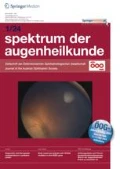Zusammenfassung
Hintergrund
Gerade beim Syndrom des trockenen Auges ist die Bewertung der subjektiven Angaben des Patienten von besonderer Bedeutung. Untersuchungen mittels standardisierter Fragebögen können die Beurteilung der Wirkung von Iodidaugeniontophorese-Therapien beim Syndrom des trockenen Auges ermöglichen.
Material und Methode
Die Auswertung von drei Studien, bei denen die subjektiven Beschwerden als Nebenparameter dokumentiert wurden, zeigt nun anhand einer größeren Fallzahl (106 Patienten) das Ausmaß der Reduktion der subjektiven Beschwerden nach Iodid-Augeniontophoresen. Es wurden jene Studien ausgewertet, bei denen der OSDI (Ocular Surface Disease Index) parallel zu einem eigenen Bad Haller Fragebogen als subjektives Bewertungskriterium herangezogen wurde.
Resultate
Nach einer Serie von 16–18 Iodid-Ophthalmoiontophoresen fanden wir den Mittelwert des OSDI (Beschwerdemaximum 100) von 35 auf 20,9 um 14,1 Punkte verbessert. Die Angaben im Bad Haller Fragebogen (Beschwerdemaximum 36) zeigen im Mittel eine Reduktion der Beschwerden von 12,4 auf 5,7 Punkte.
Schlussfolgerung
Iodid-Ophthalmoiontophoresen verbessern statistisch signifikant die subjektiven Beschwerden. Dies konnte anhand von zwei verschiedenen Fragebögen gesichert werden.
Summary
Background
Especially in dry eye syndrome the patient’s description of their subjective complaints are of particular importance. Analyses using standardized questionnaires can enable the assessment of effect of iodid-eye-iontophoreses in dry eye syndrome.
Materials and methods
The evaluation of three studies on iodine eye iontophoresis, where subjective complaints were documented as secondary parameters, shows a reduction of subjective complaints using a larger number of cases (106 patients). Those studies were used where the OSDI (ocular surface disease index) was used parallel with “Bad Haller questionnaire” subjective assessment criterion.
Results
After a series of 16–18 iodide eye iontophoresis treatments, we found the average OSDI value (maximal 100) improved from 35 to 20.9, 14.1 points. The data gathered in the Bad Hall questionnaire (maximal 36) shows a reduction of complaints from 12.4 to 5.7 points in the mean.
Conclusions
Iodide eye iontophoresis improves the subjective complaints significantly. This could be secured on the basis of two different questionnaires.



Notes
Kränzl-Nagl R, Hubatka K, Ortner T. (2011) Bericht: Auswirkungen der Augenbehandlungen in Bad Hall aus Sicht der Sicca-Patienten.
Literatur
Kastelan S, Tomic M, Salopek-Rabatic J, Novak B. Diagnostic procedures and management of dry eye. BioMed Research Intern. 2013. doi:org/10.1155/2013/309723.
Rieger G. Das trockene Auge. Spektrum der Augenheilkd. 1990; Suppl 6(4).
Sullivan BD, Whitmer D, Nichols KK, et al. An objective approach to dry eye disease severity. Invest Opthalmol Vis Sci. 2010;51(12):6125–30.
Schmetterer L, Garhöfer G. Eine multifaktorielle Erkrankung der Tränenproduktion und der Augenoberfläche. Die Punkte – Ophthalmologie. 1/2013.
Lv H, Li A, Zhang X, et al. Meta-analysis and review on the changes of tear function and corneal sensitivity in diabetic patients. Acta Opthalmol. 2014;92(2):e96–104. doi:10.1111/aos.12063.
Vehof J, Kozareva D, Hysi PG, et al. Relationship between dry eye symptoms and pain sensitivity. JAMA Ophthalmol. 2013;131(10):1304–08.
Griebenow S, Rieger G, Horwath-Winter J, Schmut O. Nachhaltigkeit der Erhöhung des wasserlöslichen antioxidativen Schutzmechanismus (ACW) in der nicht stimuliert gewonnenen Tränenflüssigkeit nach Iodid-Iontophoresebehandlungen in Bad Hall. Spektrum der Augenheilkd. 2006;20(1):6–8.
Horwath-Winter J, Schmut O, Haller-Schober EM, Gruber A, Rieger G. Iodide iontophoresis as a treatment for dry eye syndrome. Br J Ophthalmol. 2005;89:40–4.
Rieger G, Klieber M., Schimetta W, et al. The effect of iodide iontophoresis on the antioxidative capacity of the tear fluid. Graefes Arch clin Exp Ophthalmol. 2010;248:1639–46.
Kärcher T, Thelen U, Brief G, Morgan-Warren RJ, Leaback R. A prospective, multicenter, noninterventional study of Optive Plus® in the treatment of patients with dry eye: the prolipid study. Clin Ophthalmol. 2014;8:1147–55.
Llamas-Moreno JF, Baiza-Duran LM, Sauzedo-Rodriguez L, Alaniz-DelaO J. Efficacy and safety of chondroitin sulfate/xanthan gum versus polyethylene glycol/propylene glycol/hydroxypropyl guar in patients with dry eye. Clin Ophalmol. 2013;7:995–9.
Comez AT, Tufan HA, Kocabiyik Ö, Gencer B. Effects of lubricating agents with different osmolalities on tear osmolarity and other tear function test in patients with dry eye. Curr Eye Res. 2013;38(11):1095–103.
Versura P, Profazio V, Giannaccare C, Fresina M, Campos EC. Discomfort symptoms reduction and ocular surface parameters recovery with Artelac Rebalance treatment in mild-moderate dry eye. Eur J Ophthalmol. 2013;23(4):488–95.
Hussain M, Shtein RM, Sugar A, et al. Long-term use of autologous serum 50 % eye drops for the treatment of dry eye disease. Cornea. 2014;33:1245–51. doi:10.1097/ICO.000000000000027.
Versura P, Profazio V, Balducci N, Campos EC. Efficacy of two-month treatment with Xiloial® eyedrops for discomfort from disposable soft contact lenses. Clin Ophthalmol. 2014;4:1035–41.doi:10.2147/OPTH.S10448.
Kim TH, Kang JW, Kim KH, et al. Acupuncture for the treatment of dry eye: a multicentre randomised controlled trial with active comparison intervention (artificial teardrops). PloS One. 2012;7(5):e36638.
Bron AJ, Yokoi N, Gafney E, Tiffany JM. Predicted phenotypes of dry eye: proposed consequences of its natural history. Ocul Surf. 2009;7(2):78–92.
Schiffman RM, Christianson MD, Jacobsen G, Hirsch JD, Reis BL. Reliability and validity of the Ocular Surface Disease Index. Arch Opthalmol. 2000;118:615–21.
Lee JE, Kim NM, Yang JW, Kim SJ, Lee JS, Lee JE. A randomised controlled trial comparing a thermal massager with artificial teardrops fort the treatment of dry eye. Br J Ophthalmol. 2014;98:46–51. doi:10.1136/bjophthalmol-2013-303742.
Chalmers RL, Begley CG, Moody K, Hickson-Curran SB. Contact Lens Dry Eye Questionnaire-8 (CLDEQ-8) and option of contact lens performance. Optom Vis Sci. 2012;89(10):1435–42.
Smith JA, Albeitz J, Begley C et al. The epidemiology of dry eye disease: Report of the Epidemiology Subcommittee of theInternational Dry Eye WorkShop 2007. The Ocular Surface. 2007; 5(2):93-107.
Author information
Authors and Affiliations
Corresponding author
Additional information
Von der Paracelsus Gesellschaft für Balneologie und Jodforschung Herrn Prof. Doz. Dr. Gebhard Rieger anlässlich seines 75. Geburtstages gewidmet.
Rights and permissions
About this article
Cite this article
Loos, W., Rieger, G., Spitzer-Sonnleitner, B. et al. Beurteilung der Veränderung subjektiver Sicca-Beschwerden nach Iodid-Ophthalmoiontophorese durch Auswertung zweier unabhängiger Fragebögen. Spektrum Augenheilkd. 29, 99–103 (2015). https://doi.org/10.1007/s00717-015-0265-6
Received:
Accepted:
Published:
Issue Date:
DOI: https://doi.org/10.1007/s00717-015-0265-6

